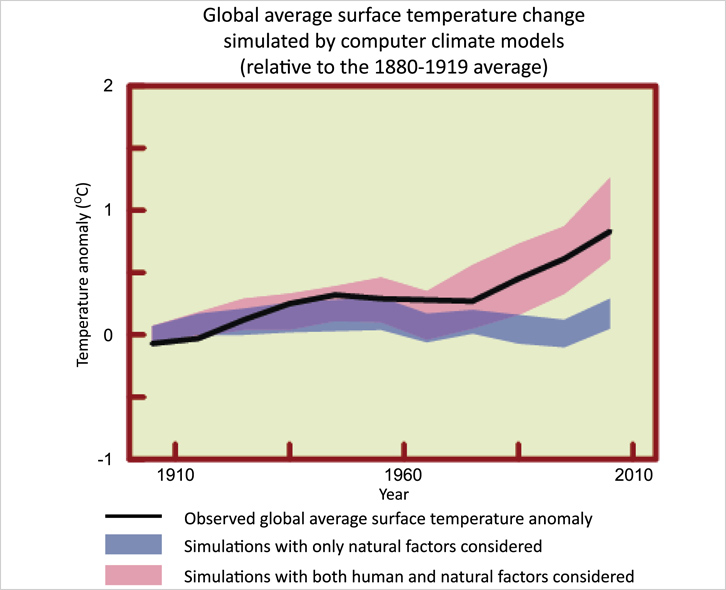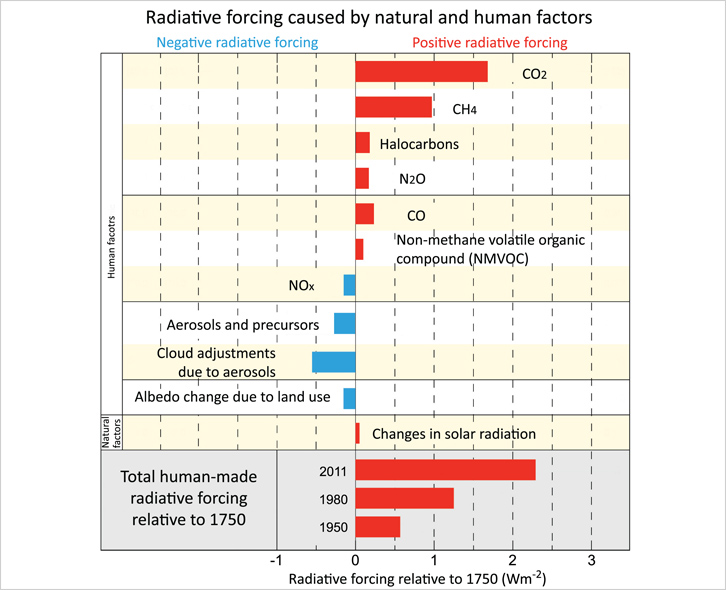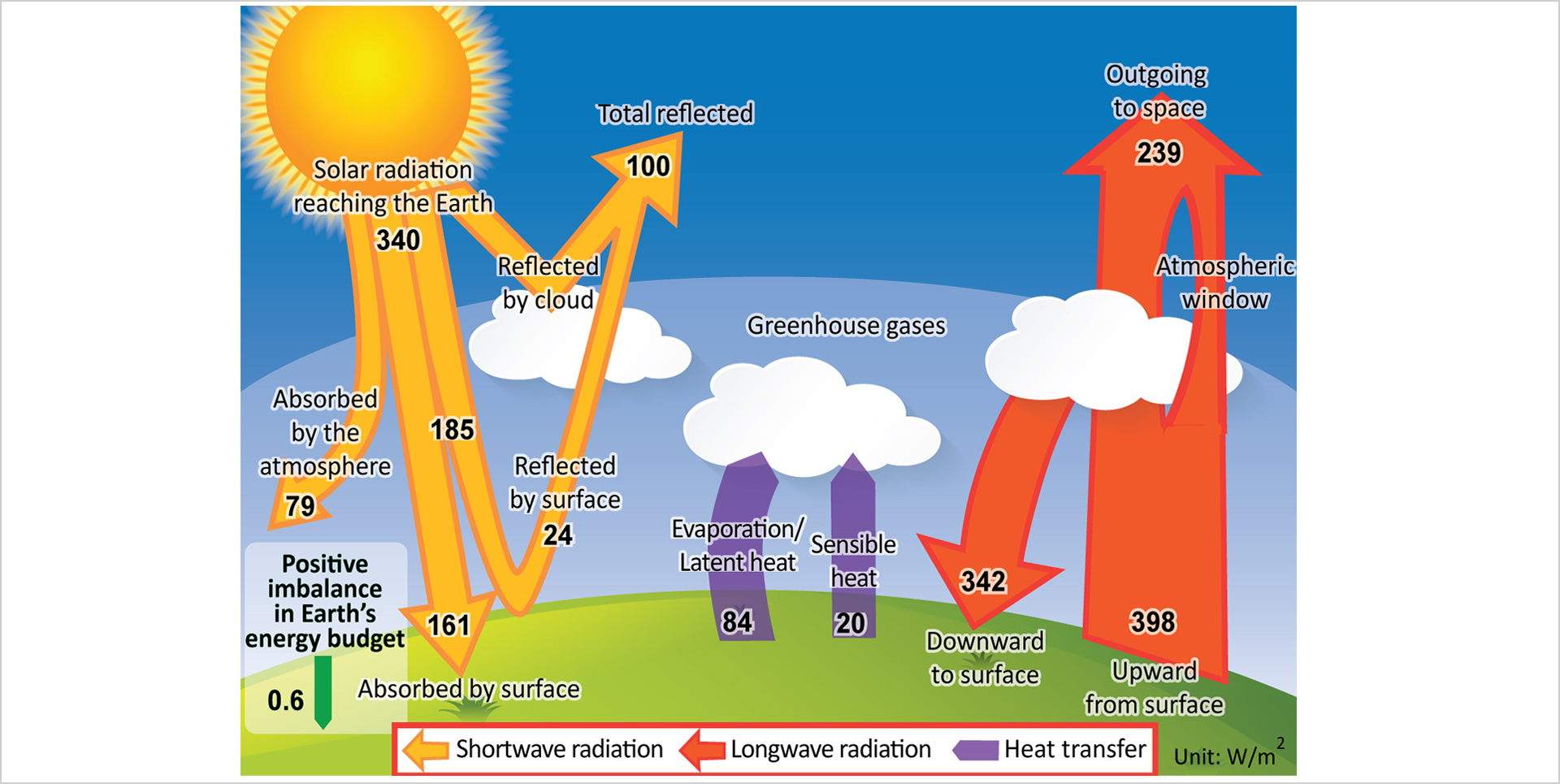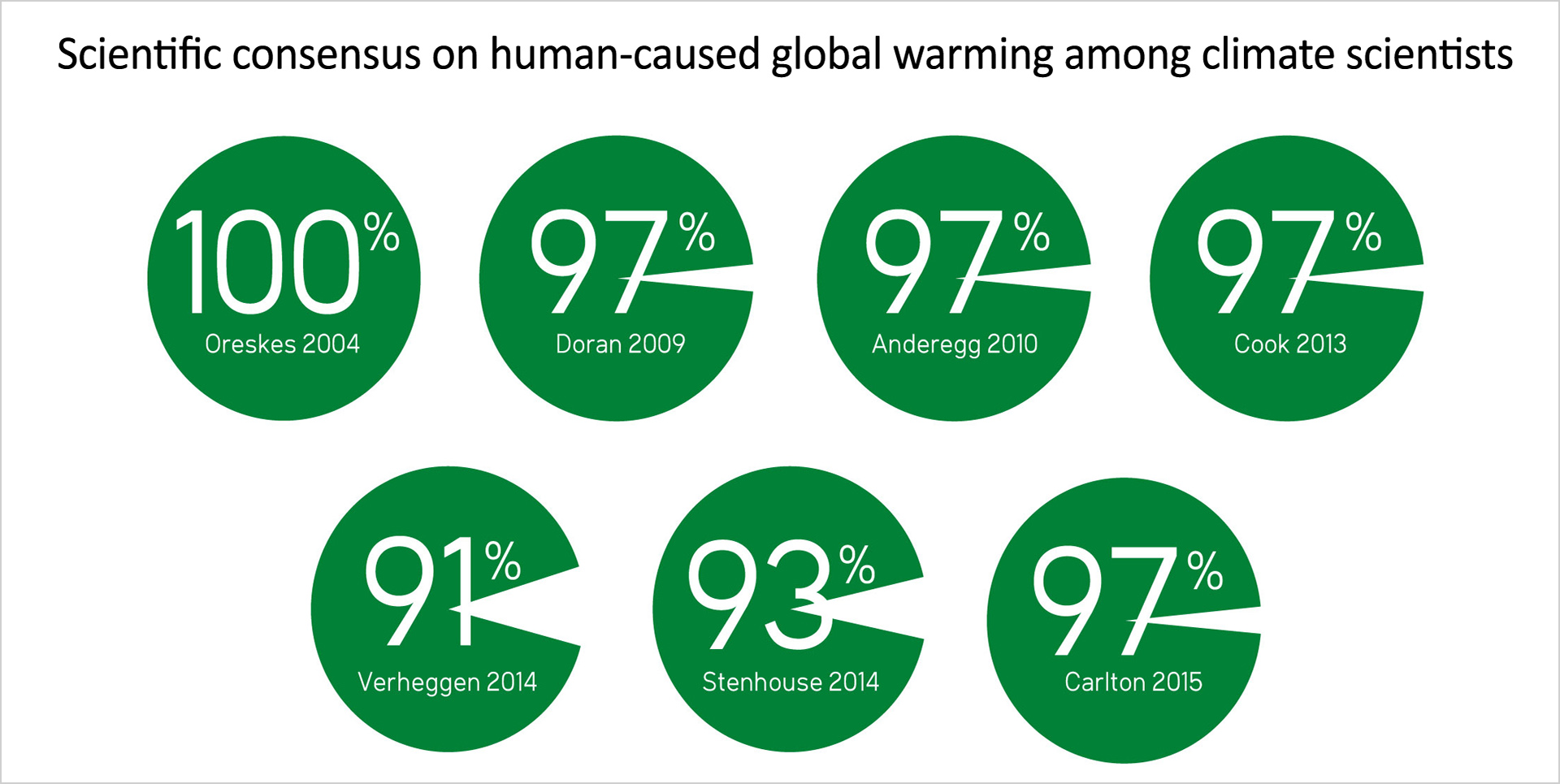Is global warming natural or human-caused?
After synthesizing the results of numerous studies and related data, Fig 2.10 shows the Earth’s energy budget under present-day conditions. The positive imbalance in the Earth’s energy budget is around 0.6 W/m2, which leads to global warming.
Fig 2.10 Earth’s energy budget under present-day conditions x (Data source: The Fifth Assessment Report of IPCC)
Why is there an imbalance in the Earth’s energy budget? Scientists use computer climate models to simulate the change in global surface temperature in the past hundred years. Fig 2.11 shows the simulation results of temperature anomaly (relative to the average of 1880-1919) under different situations.
There are significant differences between model simulations and actual observations and climate models would not be able to reproduce the observed warming if only natural factors such as the changes in the Earth’s orbit, solar activity and volcanic activity are considered. However, model simulations match with actual observations when both human and natural factors are considered, including the changes in greenhouse gas concentration, land use and man-made pollution.
The Fifth Assessment Report of IPCC clearly points out that it is extremely likely that human influence has been the dominant cause of the observed warming since the mid-20th century.
 |
|
| Fig 2.11 Global average surface temperature change simulated by computer climate models xi (Source: The Fifth Assessment Report of IPCC) |
★ More information
What’s really warming the world?
www.bloomberg.com/graphics/2015-whats-warming-the-world/
Radiative forcing
Scientists use the parameter “radiative forcing” to quantify the contribution of factors affecting global temperature. Positive radiative forcing indicates that the factor causes a positive imbalance in the Earth’s energy budget and hence warming of the Earth. Negative radiative forcing indicates that the factor causes a negative imbalance in the Earth’s energy budget and hence cooling of the Earth.
As shown in Fig 2.12, carbon dioxide has the highest positive radiative forcing, followed by methane. Human activities such as changing land uses and releasing aerosols to the atmosphere will cause an increase in albedo, leading to negative radiative forcing. The net human-caused radiative forcing is positive, far greater than the contribution of solar activities.
 |
|
| Fig 2.12 Radiative forcing caused by natural and human factors xii (Source: The Fifth Assessment Report of IPCC) |
★ More information
Global warming: Clear and Present Danger (1)
www.hkedcity.net/etv/resource/82394694
The 97% scientific consensus
Over the past 20 years, many studies examined the consensus on human-caused global warming among climate scientists. The scientific consensus was found to be between 90% and 100%.
Fig 2.13 Scientific consensus on human-caused global warming among climate scientists xiii (Source: Skeptical Science)
In The Consensus Projectiv released in 2013, researchers examined the abstracts of more than 10,000 peer-reviewed scientific papers in the past 20 years and found 97% of the papers expressing a position endorsing the human-caused global warming assessment.
★ More information
Are you aware of the scientific consensus on global warming?
https://www.hko.gov.hk/blog/en/archives/00000154.htm
➤ Assessment Reports of Intergovernmental Panel on Climate Change (IPCC)
IPCC publishes assessment reports every several years, summarizing the results of scientific researches worldwide. The assessment reports represent the scientific consensus on climate change. IPCC has published five assessment reports since 1990. The main conclusions are as follows. (See teaching kit 7.1 “Scientific evidence of climate change” for more information about IPCC)
1990 The First Assessment Report︰ https://archive.ipcc.ch/ipccreports/far/wg_I/ipcc_far_wg_I_full_report.pdf
- Global mean surface temperature has increased by 0.3°C to 0.6°C over the last 100 years
- The size of this warming is broadly consistent with predictions of climate models, but it is also of the same magnitude as natural climate variability
1995 The Second Assessment Report︰https://archive.ipcc.ch/ipccreports/sar/wg_I/ipcc_sar_wg_I_full_report.pdf
- The balance of evidence suggests that there is a discernible human influence on global climate
2001 The Third Assessment Report︰https://www.ipcc.ch/site/assets/uploads/2018/07/WG1_TAR_SPM.pdf
- The warming over the past 100 years is very unlikely (1-10% chance) to be due to internal variability alone
- Most of the observed warming over the last 50 years is likely to have been due to the increase in greenhouse gas concentrations
2007 The Fourth Assessment Report︰www.ipcc.ch/report/ar4/wg1/
- Warming of the climate system is unequivocal
- Most of the observed increase in global average temperature since the mid-20th century is very likely (>90% chance) due to the observed increase in human-caused greenhouse gas concentrations
2013 The Fifth Assessment Report︰www.climatechange2013.org
- Warming of the climate system is unequivocal, and since the 1950s, many of the observed changes are unprecedented over decades to millennia
- It is extremely likely (95-100% chance) that human influence has been the dominant cause of the observed warming since the mid-20thcentury
Source of figures and data in Chapter 7.2
[i] https://www.ipcc.ch/report/ar5/wg1/observations-atmosphere-and-surface/fig2-11_orig-pptx-2/
[ii] www.skepticalscience.com/solar-activity-sunspots-global-warming.htm
[iii] https://nsidc.org/cryosphere/seaice/processes/albedo.html
[iv] https://www.hko.gov.hk/m/article_e.htm?title=ele_00246
[v] https://www.hko.gov.hk/climate_change/faq/faq_e.htm#Q201704
[vi] https://www.ipcc.ch/site/assets/uploads/2018/02/box-ts-6-1024×608.jpg
[vii] https://scripps.ucsd.edu/programs/keelingcurve/
[viii] http://www.fao.org/resources/infographics/infographics-details/en/c/325836/
[ix] https://www.ipcc.ch/site/assets/uploads/2018/02/Fig6-11-2-1024×793.jpg
[x] https://www.ipcc.ch/site/assets/uploads/2018/02/Fig2-11-1-1024×673.jpg
[xi] https://archive.ipcc.ch/pdf/assessment-report/ar5/syr/AR5_SYR_FINAL_All_Topics.pdf (P. 49)
[xii] https://www.ipcc.ch/site/assets/uploads/2018/02/FigSPM-05.jpg



